steering wheel MITSUBISHI L200 2004 Owner's Manual (in English)
[x] Cancel search | Manufacturer: MITSUBISHI, Model Year: 2004, Model line: L200, Model: MITSUBISHI L200 2004Pages: 264, PDF Size: 4.14 MB
Page 34 of 264
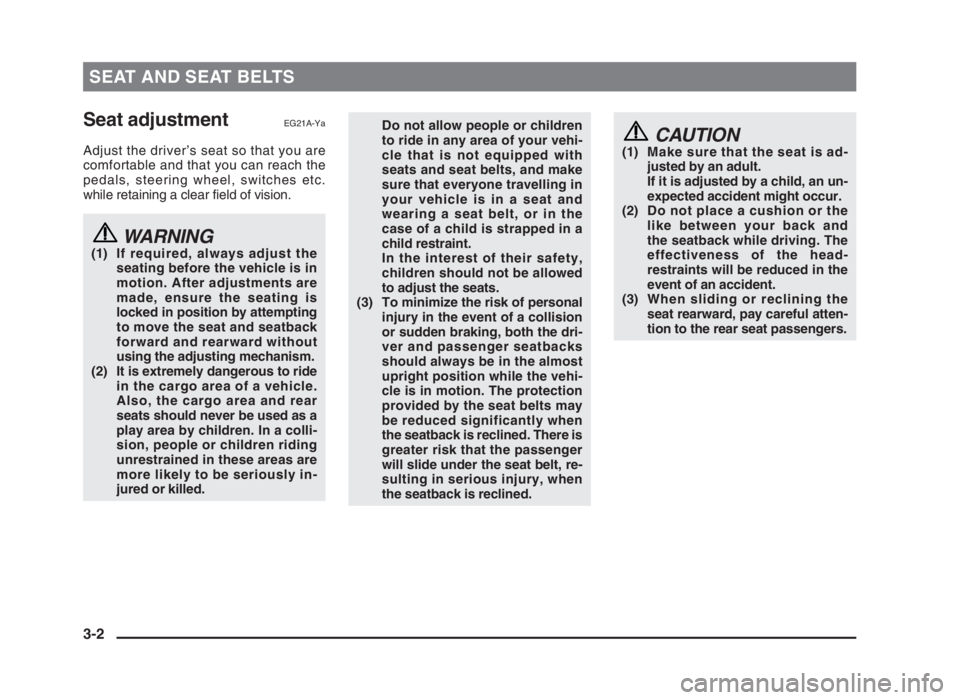
SEAT AND SEAT BELTS
Seat adjustmentEG21A-Ya
Adjust the driver’s seat so that you are
comfortable and that you can reach the
pedals, steering wheel, switches etc.
while retaining a clear field of vision.
WARNING(1) If required, always adjust the
seating before the vehicle is in
motion. After adjustments are
made, ensure the seating is
locked in position by attempting
to move the seat and seatback
forward and rearward without
using the adjusting mechanism.
(2) It is extremely dangerous to ride
in the cargo area of a vehicle.
Also, the cargo area and rear
seats should never be used as a
play area by children. In a colli-
sion, people or children riding
unrestrained in these areas are
more likely to be seriously in-
jured or killed.
Do not allow people or children
to ride in any area of your vehi-
cle that is not equipped with
seats and seat belts, and make
sure that everyone travelling in
your vehicle is in a seat and
wearing a seat belt, or in the
case of a child is strapped in a
child restraint.
In the interest of their safety,
children should not be allowed
to adjust the seats.
(3) To minimize the risk of personal
injury in the event of a collision
or sudden braking, both the dri-
ver and passenger seatbacks
should always be in the almost
upright position while the vehi-
cle is in motion. The protection
provided by the seat belts may
be reduced significantly when
the seatback is reclined. There is
greater risk that the passenger
will slide under the seat belt, re-
sulting in serious injury, when
the seatback is reclined.CAUTION(1) Make sure that the seat is ad-
justed by an adult.
If it is adjusted by a child, an un-
expected accident might occur.
(2) Do not place a cushion or the
like between your back and
the seatback while driving. The
effectiveness of the head-
restraints will be reduced in the
event of an accident.
(3) When sliding or reclining the
seat rearward, pay careful atten-
tion to the rear seat passengers.
3-2
03engL2_240082_4 22-01-2004 13:01 Page 3-2
Page 41 of 264
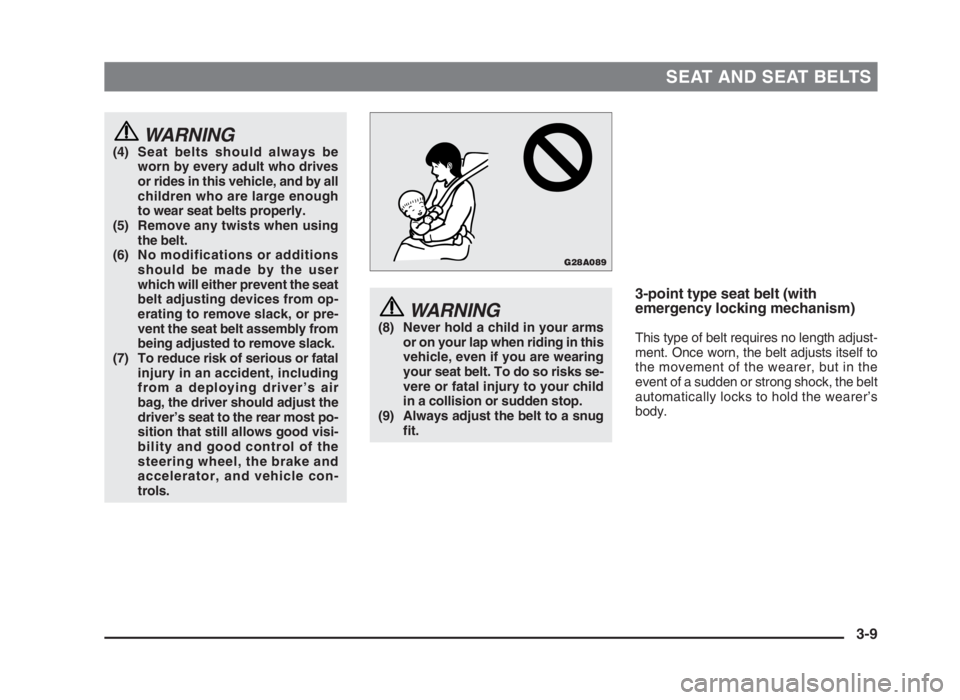
SEAT AND SEAT BELTS
WARNING(4) Seat belts should always be
worn by every adult who drives
or rides in this vehicle, and by all
children who are large enough
to wear seat belts properly.
(5) Remove any twists when using
the belt.
(6) No modifications or additions
should be made by the user
which will either prevent the seat
belt adjusting devices from op-
erating to remove slack, or pre-
vent the seat belt assembly from
being adjusted to remove slack.
(7) To reduce risk of serious or fatal
injury in an accident, including
from a deploying driver’s air
bag, the driver should adjust the
driver’s seat to the rear most po-
sition that still allows good visi-
bility and good control of the
steering wheel, the brake and
accelerator, and vehicle con-
trols.
3-point type seat belt (with
emergency locking mechanism)
This type of belt requires no length adjust-
ment. Once worn, the belt adjusts itself to
the movement of the wearer, but in the
event of a sudden or strong shock, the belt
automatically locks to hold the wearer’s
body.
WARNING(8) Never hold a child in your arms
or on your lap when riding in this
vehicle, even if you are wearing
your seat belt. To do so risks se-
vere or fatal injury to your child
in a collision or sudden stop.
(9) Always adjust the belt to a snug
fit.
3-9
G28A089
03engL2_240082_4 22-01-2004 13:01 Page 3-9
Page 53 of 264
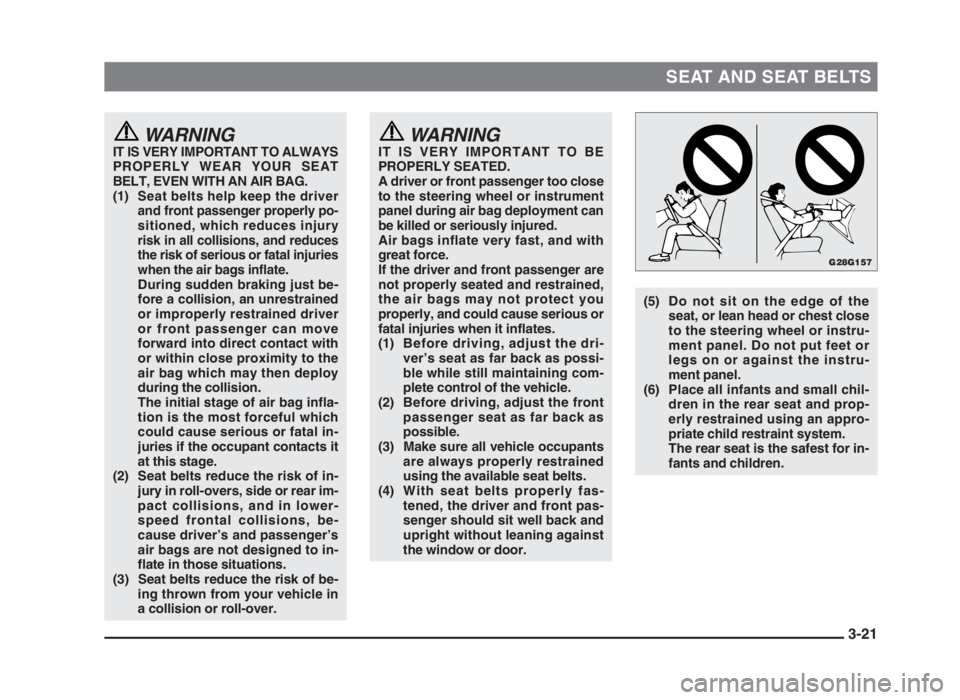
SEAT AND SEAT BELTS
3-21
WARNINGIT IS VERY IMPORTANT TO ALWAYS
PROPERLY WEAR YOUR SEAT
BELT, EVEN WITH AN AIR BAG.
(1)
Seat belts help keep the driver
and front passenger properly po-
sitioned, which reduces injury
risk in all collisions, and reduces
the risk of serious or fatal injuries
when the air bags inflate.
During sudden braking just be-
fore a collision, an unrestrained
or improperly restrained driver
or front passenger can move
forward into direct contact with
or within close proximity to the
air bag which may then deploy
during the collision.
The initial stage of air bag infla-
tion is the most forceful which
could cause serious or fatal in-
juries if the occupant contacts it
at this stage.
(2) Seat belts reduce the risk of in-
jury in roll-overs, side or rear im-
pact collisions, and in lower-
speed frontal collisions, be-
cause driver’s and passenger’s
air bags are not designed to in-
flate in those situations.
(3) Seat belts reduce the risk of be-
ing thrown from your vehicle in
a collision or roll-over.
(5) Do not sit on the edge of the
seat, or lean head or chest close
to the steering wheel or instru-
ment panel. Do not put feet or
legs on or against the instru-
ment panel.
(6) Place all infants and small chil-
dren in the rear seat and prop-
erly restrained using an appro-
priate child restraint system.
The rear seat is the safest for in-
fants and children.
WARNINGIT IS VERY IMPORTANT TO BE
PROPERLY SEATED.
A driver or front passenger too close
to the steering wheel or instrument
panel during air bag deployment can
be killed or seriously injured.
Air bags inflate very fast, and with
great force.
If the driver and front passenger are
not properly seated and restrained,
the air bags may not protect you
properly, and could cause serious or
fatal injuries when it inflates.
(1) Before driving, adjust the dri-
ver’s seat as far back as possi-
ble while still maintaining com-
plete control of the vehicle.
(2) Before driving, adjust the front
passenger seat as far back as
possible.
(3) Make sure all vehicle occupants
are always properly restrained
using the available seat belts.
(4) With seat belts properly fas-
tened, the driver and front pas-
senger should sit well back and
upright without leaning against
the window or door.
G28G157
03engL2_240082_4 22-01-2004 13:01 Page 3-21
Page 56 of 264
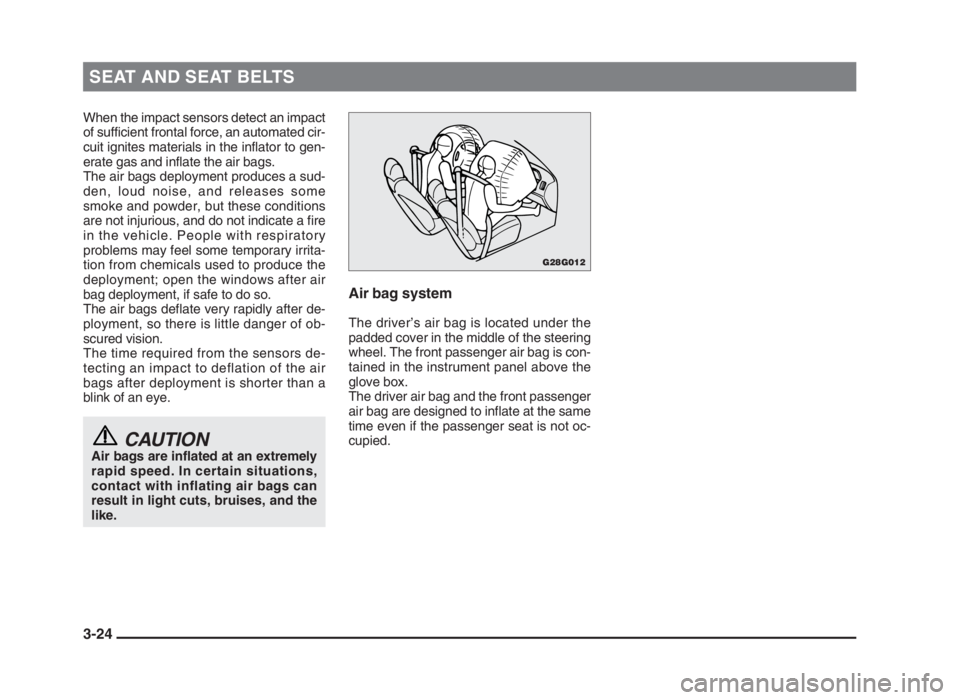
SEAT AND SEAT BELTS
3-24
When the impact sensors detect an impact
of sufficient frontal force, an automated cir-
cuit ignites materials in the inflator to gen-
erate gas and inflate the air bags.
The air bags deployment produces a sud-
den, loud noise, and releases some
smoke and powder, but these conditions
are not injurious, and do not indicate a fire
in the vehicle. People with respiratory
problems may feel some temporary irrita-
tion from chemicals used to produce the
deployment; open the windows after air
bag deployment, if safe to do so.
The air bags deflate very rapidly after de-
ployment, so there is little danger of ob-
scured vision.
The time required from the sensors de-
tecting an impact to deflation of the air
bags after deployment is shorter than a
blink of an eye.
CAUTIONAir bags are inflated at an extremely
rapid speed. In certain situations,
contact with inflating air bags can
result in light cuts, bruises, and the
like.
Air bag system
The driver’s air bag is located under the
padded cover in the middle of the steering
wheel. The front passenger air bag is con-
tained in the instrument panel above the
glove box.
The driver air bag and the front passenger
air bag are designed to inflate at the same
time even if the passenger seat is not oc-
cupied.
G28G012
03engL2_240082_4 22-01-2004 13:01 Page 3-24
Page 57 of 264
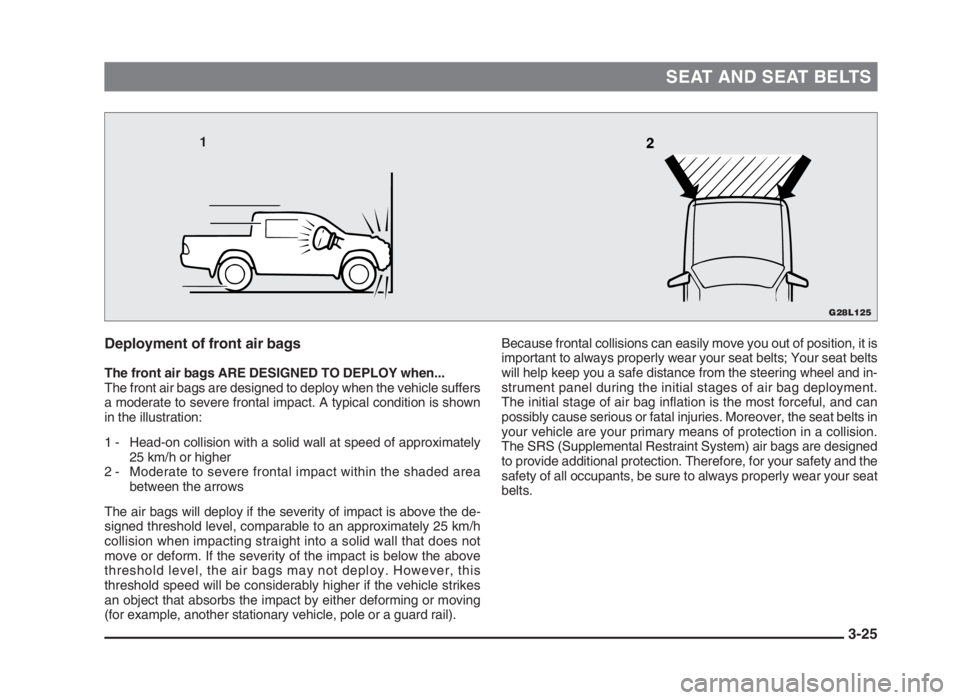
SEAT AND SEAT BELTS
3-25 Deployment of front air bags
The front air bags ARE DESIGNED TO DEPLOY when...
The front air bags are designed to deploy when the vehicle suffers
a moderate to severe frontal impact. A typical condition is shown
in the illustration:
1 - Head-on collision with a solid wall at speed of approximately
25 km/h or higher
2 - Moderate to severe frontal impact within the shaded area
between the arrows
The air bags will deploy if the severity of impact is above the de-
signed threshold level, comparable to an approximately 25 km/h
collision when impacting straight into a solid wall that does not
move or deform. If the severity of the impact is below the above
threshold level, the air bags may not deploy. However, this
threshold speed will be considerably higher if the vehicle strikes
an object that absorbs the impact by either deforming or moving
(for example, another stationary vehicle, pole or a guard rail).Because frontal collisions can easily move you out of position, it is
important to always properly wear your seat belts; Your seat belts
will help keep you a safe distance from the steering wheel and in-
strument panel during the initial stages of air bag deployment.
The initial stage of air bag inflation is the most forceful, and can
possibly cause serious or fatal injuries. Moreover, the seat belts in
your vehicle are your primary means of protection in a collision.
The SRS (Supplemental Restraint System) air bags are designed
to provide additional protection. Therefore, for your safety and the
safety of all occupants, be sure to always properly wear your seat
belts.
1
G28L125
03engL2_240082_4 22-01-2004 13:01 Page 3-25
Page 60 of 264
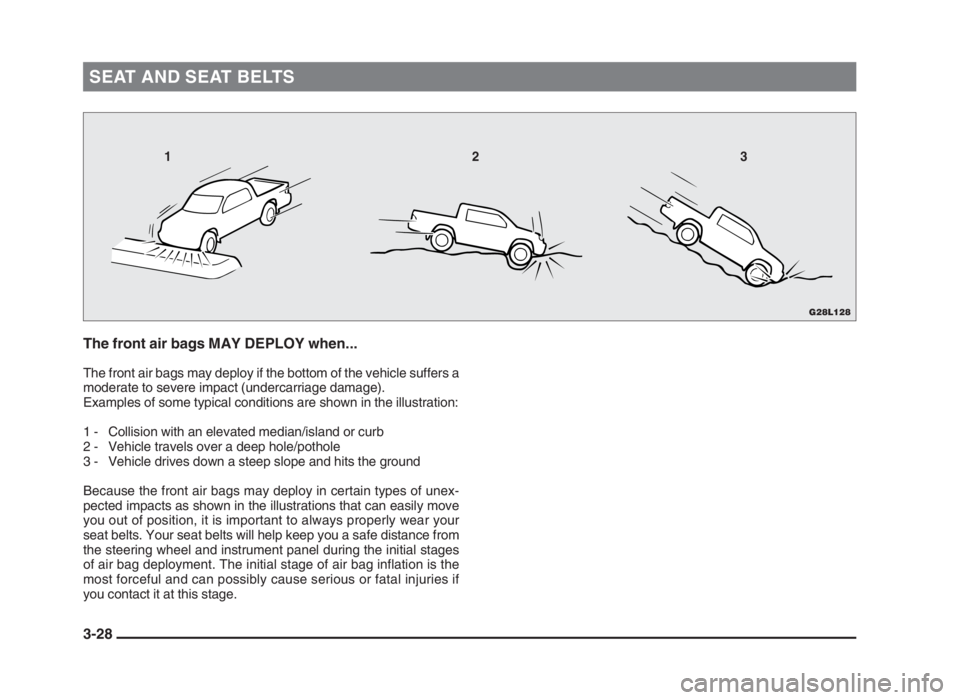
SEAT AND SEAT BELTS
3-28 The front air bags MAY DEPLOY when...
The front air bags may deploy if the bottom of the vehicle suffers a
moderate to severe impact (undercarriage damage).
Examples of some typical conditions are shown in the illustration:
1 - Collision with an elevated median/island or curb
2 - Vehicle travels over a deep hole/pothole
3 - Vehicle drives down a steep slope and hits the ground
Because the front air bags may deploy in certain types of unex-
pected impacts as shown in the illustrations that can easily move
you out of position, it is important to always properly wear your
seat belts. Your seat belts will help keep you a safe distance from
the steering wheel and instrument panel during the initial stages
of air bag deployment. The initial stage of air bag inflation is the
most forceful and can possibly cause serious or fatal injuries if
you contact it at this stage.
G28L128
123
03engL2_240082_4 22-01-2004 13:01 Page 3-28
Page 61 of 264
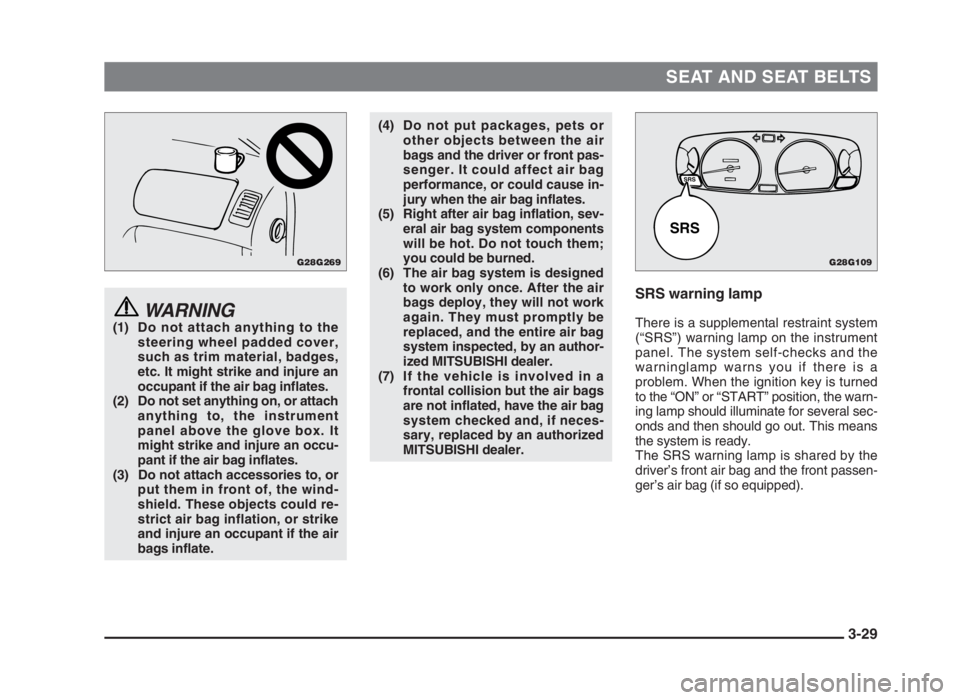
SEAT AND SEAT BELTS
3-29
WARNING(1) Do not attach anything to the
steering wheel padded cover,
such as trim material, badges,
etc. It might strike and injure an
occupant if the air bag inflates.
(2) Do not set anything on, or attach
anything to, the instrument
panel above the glove box. It
might strike and injure an occu-
pant if the air bag inflates.
(3) Do not attach accessories to, or
put them in front of, the wind-
shield. These objects could re-
strict air bag inflation, or strike
and injure an occupant if the air
bags inflate.
SRS warning lamp
There is a supplemental restraint system
(“SRS”) warning lamp on the instrument
panel. The system self-checks and the
warninglamp warns you if there is a
problem. When the ignition key is turned
to the “ON” or “START” position, the warn-
ing lamp should illuminate for several sec-
onds and then should go out. This means
the system is ready.
The SRS warning lamp is shared by the
driver’s front air bag and the front passen-
ger’s air bag (if so equipped).
(4) Do not put packages, pets or
other objects between the air
bags and the driver or front pas-
senger. It could affect air bag
performance, or could cause in-
jury when the air bag inflates.
(5) Right after air bag inflation, sev-
eral air bag system components
will be hot. Do not touch them;
you could be burned.
(6) The air bag system is designed
to work only once. After the air
bags deploy, they will not work
again. They must promptly be
replaced, and the entire air bag
system inspected, by an author-
ized MITSUBISHI dealer.
(7) If the vehicle is involved in a
frontal collision but the air bags
are not inflated, have the air bag
system checked and, if neces-
sary, replaced by an authorized
MITSUBISHI dealer.
G28G269G28G109
SRS
SRS
03engL2_240082_4 22-01-2004 13:01 Page 3-29
Page 62 of 264
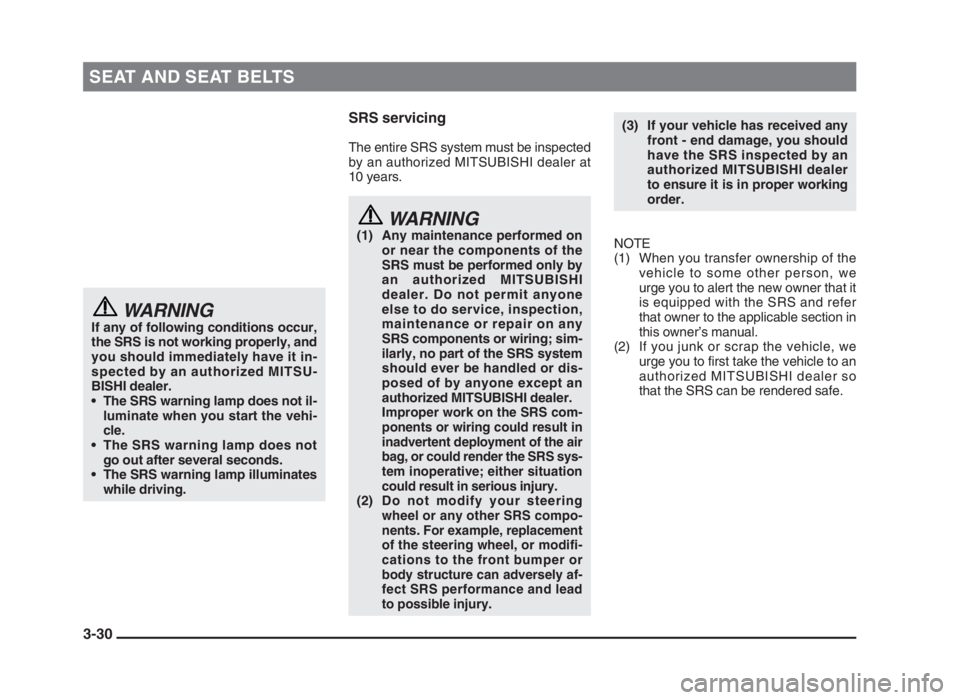
SEAT AND SEAT BELTS
3-30
WARNINGIf any of following conditions occur,
the SRS is not working properly, and
you should immediately have it in-
spected by an authorized MITSU-
BISHI dealer.
• The SRS warning lamp does not il-
luminate when you start the vehi-
cle.
• The SRS warning lamp does not
go out after several seconds.
• The SRS warning lamp illuminates
while driving.
SRS servicing
The entire SRS system must be inspected
by an authorized MITSUBISHI dealer at
10 years.
WARNING(1) Any maintenance performed on
or near the components of the
SRS must be performed only by
an authorized MITSUBISHI
dealer. Do not permit anyone
else to do service, inspection,
maintenance or repair on any
SRS components or wiring; sim-
ilarly, no part of the SRS system
should ever be handled or dis-
posed of by anyone except an
authorized MITSUBISHI dealer.
Improper work on the SRS com-
ponents or wiring could result in
inadvertent deployment of the air
bag, or could render the SRS sys-
tem inoperative; either situation
could result in serious injury.
(2)Do not modify your steering
wheel or any other SRS compo-
nents. For example, replacement
of the steering wheel, or modifi-
cations to the front bumper or
body structure can adversely af-
fect SRS performance and lead
to possible injury.
(3) If your vehicle has received any
front - end damage, you should
have the SRS inspected by an
authorized MITSUBISHI dealer
to ensure it is in proper working
order.
NOTE
(1) When you transfer ownership of the
vehicle to some other person, we
urge you to alert the new owner that it
is equipped with the SRS and refer
that owner to the applicable section in
this owner’s manual.
(2) If you junk or scrap the vehicle, we
urge you to first take the vehicle to an
authorized MITSUBISHI dealer so
that the SRS can be rendered safe.
03engL2_240082_4 22-01-2004 13:01 Page 3-30
Page 77 of 264
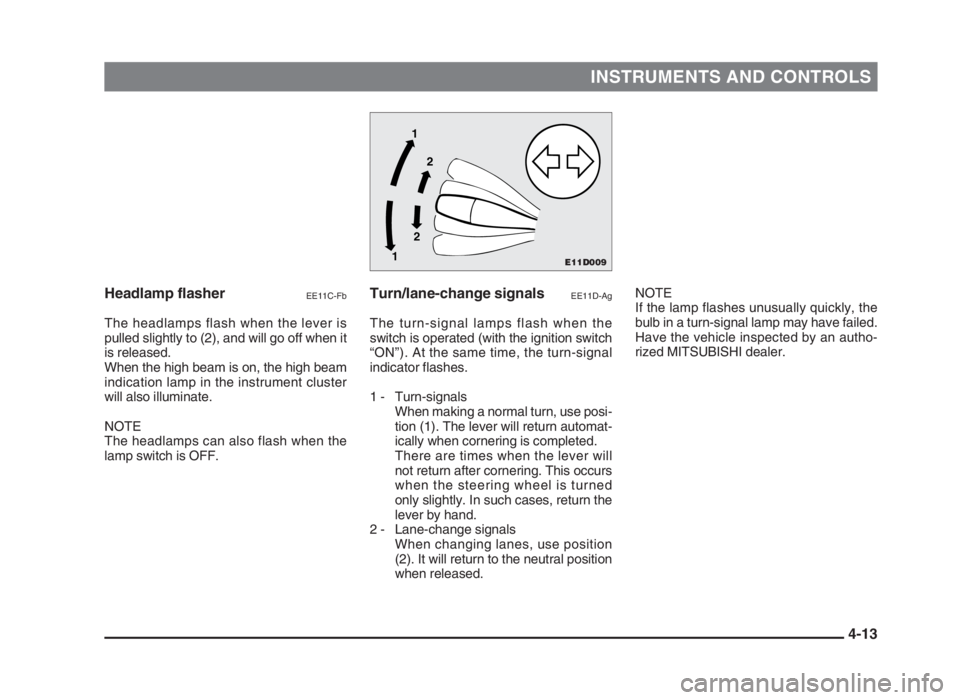
INSTRUMENTS AND CONTROLS
4-13 Headlamp flasher
EE11C-Fb
The headlamps flash when the lever is
pulled slightly to (2), and will go off when it
is released.
When the high beam is on, the high beam
indication lamp in the instrument cluster
will also illuminate.
NOTE
The headlamps can also flash when the
lamp switch is OFF.
Turn/lane-change signalsEE11D-Ag
The turn-signal lamps flash when the
switch is operated (with the ignition switch
“ON”). At the same time, the turn-signal
indicator flashes.
1 - Turn-signals
When making a normal turn, use posi-
tion (1). The lever will return automat-
ically when cornering is completed.
There are times when the lever will
not return after cornering. This occurs
when the steering wheel is turned
only slightly. In such cases, return the
lever by hand.
2 - Lane-change signals
When changing lanes, use position
(2). It will return to the neutral position
when released.NOTE
If the lamp flashes unusually quickly, the
bulb in a turn-signal lamp may have failed.
Have the vehicle inspected by an autho-
rized MITSUBISHI dealer.
E11D009
1
2
2
1
04engL2_240082_4 22-01-2004 13:20 Page 4-13
Page 84 of 264
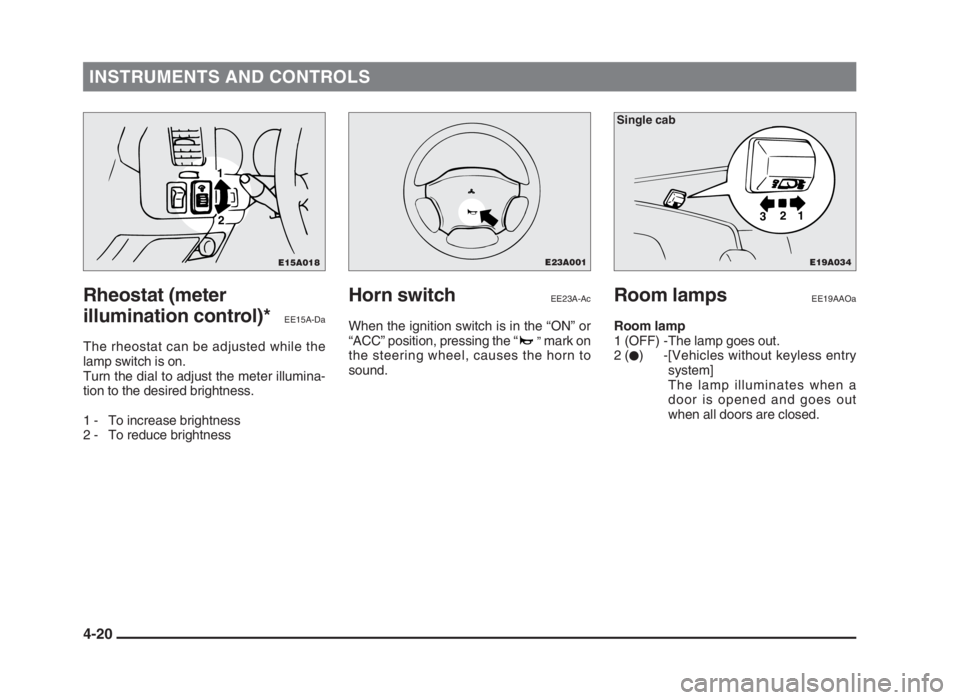
INSTRUMENTS AND CONTROLS
4-20
Rheostat (meter
illumination control)*
EE15A-Da
The rheostat can be adjusted while the
lamp switch is on.
Turn the dial to adjust the meter illumina-
tion to the desired brightness.
1 - To increase brightness
2 - To reduce brightness
Room lampsEE19AAOa
Room lamp
1 (OFF) -The lamp goes out.
2 (
•) -[Vehicles without keyless entry
system]
The lamp illuminates when a
door is opened and goes out
when all doors are closed.
Horn switchEE23A-Ac
When the ignition switch is in the “ON” or
“ACC” position, pressing the “”mark on
the steering wheel, causes the horn to
sound.
E19A034
1 2
3
Single cab
E23A001E15A018
1
2
04engL2_240082_4 22-01-2004 13:20 Page 4-20